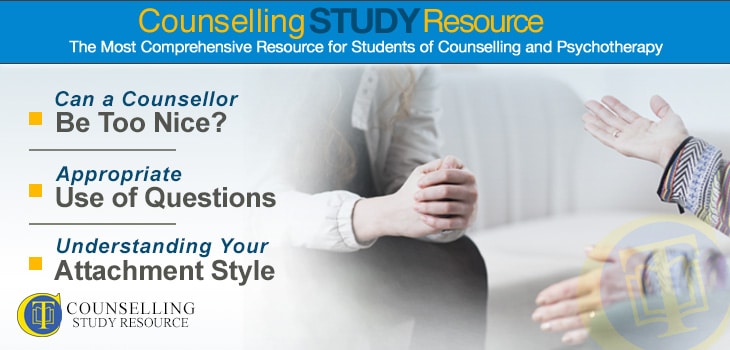098 – Use of Questions in Counselling
Can a Counsellor Be Too Nice? – Understanding Your Attachment Style
In episode 98 of the Counselling Tutor Podcast, Ken Kelly and Rory Lees-Oakes discuss whether it’s possible for a counsellor to be too nice. In ‘Practice Matters’, Rory then talks about the appropriate use of questions in counselling. Finally, the presenters explore attachment styles, and how these can affect the therapeutic relationship.
Can a Counsellor Be Too Nice? (starts at 2.07 mins)
In his book Against Therapy (Common Courage Press, 1993), Jeffrey Masson criticises person-centred therapy as being a ‘cult of kindly benevolence’.
Indeed, the stereotypical view of counsellors can be as people who simply smile and nod.
The truth, however, is that we need to be able to hold a mirror up to our clients, reflecting the effects of their behaviour and challenging this when appropriate.
If you can’t or won’t challenge (which does take courage), you run the risk of colluding with the client. Collusion is when the client looks for your buy-in to something they say.
Challenging is not the same as judging. Congruence on the part of the counsellor is vital for effective person-centred counselling, and it is this core condition that underlies the skill of challenge.
Brian Thorne, a well-known British lecturer and writer on person-centred counselling, reports that Carl Rogers – when visiting the UK – claimed that British people were ‘too damned polite’ for this modality to be effective here.
We must guard against this, by looking out for and avoiding collusion, and being willing to challenge (once we have established a supportive relationship with the client).
Appropriate Use of Questions in Counselling (starts at 11.52 mins)
In this section, Rory describes the proper use of questions in counselling—how questions should be used only minimally in counselling, and how their use varies between the therapeutic relationship and other relationships (e.g. in social situations with friends).
One of the most contentious questions in practice is ‘why’. Rory examines the rationale for avoiding this, and also explores the different uses of open and closed questions in counselling.
Understanding Your Attachment Style (starts at 15.05 mins)
Is it important to understand your own attachment style. This question was asked recently in our Facebook group, which includes over 21,000 people (students, tutors and qualified counsellors) interested in the world of counselling and psychotherapy.
Attachment styles explain how comfortable we feel with other people, and how we handle relationships.
The term was introduced in research by British psychiatrist, psychologist and psychoanalyst John Bowlby, just after the Second World War.
Our attachment style develops as a result of our experience with our care-givers as children.
There are four main attachment styles (originally three, with the fourth having been added in the 19802):
- secure attachment – which can be summarised as ‘I’m OK, you’re OK’
- ambivalent attachment – ‘I’m not OK, you’re OK’
- avoidant/dismissive attachment – ‘I’m OK, you’re not OK’
- disorganised/reactive attachment – ‘I’m not OK, you’re not OK’.
Ken and Rory open up to share their own stories of how their childhood experiences led them to have the avoidant/dismissive attachment style.
While it is possible to learn to relate to others in different ways – for example, the presenters have both since learned how to access a secure attachment style through their personal development (including in counselling training) – they explain that it is impossible to completely banish your original style, meaning that you may find yourself reverting to this in times of stress.
Our attachment style inevitably impacts on the relationship we have with our clients. It is therefore very important to understand this.
You can learn more about attachment theory on the Counselling Tutor website.


